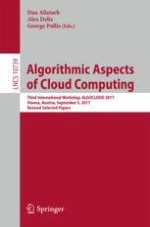2018 | OriginalPaper | Buchkapitel
Risk Aware Stochastic Placement of Cloud Services: The Case of Two Data Centers
verfasst von : Galia Shabtai, Danny Raz, Yuval Shavitt
Erschienen in: Algorithmic Aspects of Cloud Computing
Aktivieren Sie unsere intelligente Suche, um passende Fachinhalte oder Patente zu finden.
Wählen Sie Textabschnitte aus um mit Künstlicher Intelligenz passenden Patente zu finden. powered by
Markieren Sie Textabschnitte, um KI-gestützt weitere passende Inhalte zu finden. powered by
